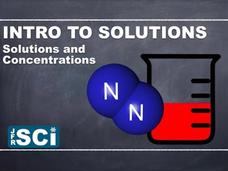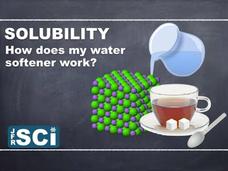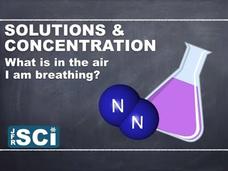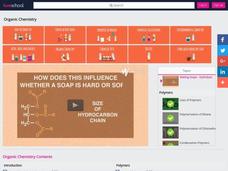Professor Dave Explains
Solubility and the Born-Haber Cycle
Why do some things dissolve in water while others don't? Is a supersaturated solution just a beaker with a cape? All this and more!
FuseSchool
Solubility Curves
Learn the basics about solubility curves as a part of the overall properties of matter topic. Solubility curves are a graphical representation of the solubility of a certain salt over a temperature range. Copper (II) sulfate is a lot...
Professor Dave Explains
Separating Components of a Mixture by Extraction
Looking at extraction as a separation technique.
Schooling Online
Chemistry Properties and Structure of Matter: Properties of Matter - Separation Techniques Part 4
Cookie the chef is a multitalented guy. He’s an amazing barista, too! He really takes filter coffee to the next level. Meanwhile, First Mate Phil needs a hand, or a hook, with fixing the ship’s hull. This lesson will explore separation...
Visual Learning Systems
Exploring the Complex Nature of Solutions
In this video, we explore the concept of solubility and how different substances dissolve in water. We learn that solubility refers to the amount of solute that can be dissolved in a solvent, and that a saturated solution holds the...
FuseSchool
Solubility Rules
Learn the basics about solubility rules for insoluble salts, as part of the overall acids, bases and alkali topic.
FuseSchool
Paper & Thin Layer Chromatography
Learn the basics about Paper and Thin Layer Chromatography. What is Chromatography and why is it done? Find out more in this video!
Visual Learning Systems
Solutions at Work: Solubility and Solutions
Upon viewing the Solutions at Work video series, students will be able to do the following: Explain that a solution is a type of mixture made of two or more substances that are evenly distributed. Provide an example of a common solution....
JFR Science
Introduction to Solutions: Solutions and Concentration
Don't break your concentration when learning about solutions. Pupils watch a video in the JFR Science series that explains what solutions are and how to calculate solution concentrations. The resource covers solubility and molar...
JFR Science
Solubility and Reactions in Solution: How Does My Water Softener Work?
What is soap scum, and why does it form? Explore hard versus soft water with a video from JFR Science. The narrator explains why someone might have hard water, the factors that affect ion solubility, and how a water softener addresses...
JFR Science
Solution Stoichiometry: How Much Vinegar Is Needed to Clean My Teapot?
Solution stoichiometry ... reducing waste, one calculation at a time. Chemistry scholars examine the concepts and calculations involved in solution stoichiometry with a video from JFR Science. The narrator gives examples of when to use...
JFR Science
Solution and Concentration: What Is in the Air I'm Breathing?
What makes air fresh or not so fresh? The solution is solution chemistry! Explore homogeneous mixtures with a video from the JFR Science series. The narrator explains a variety of solution terms, how to classify solutions, and how people...
JFR Science
Double Displacement Reactions: What Is a Barium swallow?
Here is a video that is a double displacement delight! Show young scientists how to tackle the longest (and most interesting) chemical reactions to write with a video from JFR Science. The narrator shows examples of double displacement...
Teacher's Pet
Reactions in Aqueous Solutions
Chemical reactions take a dip in this lesson. Learners watch as the instructor describes the role of aqueous solutions in reactions. They learn how to write a net ionic equation by eliminating spectator ions and also explore solubility...
Teacher's Pet
Acid-Base Theories
This is definitely not your basic acid-base resource! Science scholars compare acid-base theories in a brief video. Content includes properties of acids and bases, the principles of each acid-base theory, and the role water plays in...
Teacher's Pet
Solubility Equilibrium
Looking for a well-balanced resource about solubility equilibrium? Solution scholars examine the factors that affect solubility and Le Chatelier's Principle in a short video. The content includes soluble and insoluble compounds,...
Fuse School
Making Soaps - Hydrolysis
Don't let teaching about hydrolysis burst your bubble! Introduce your class to soap-making with an animated video. The narrator describes the raw materials used for making both hard and soft soaps. The video includes a look at early soap...
Fuse School
Properties of Water
The Universal Solvent? Module nine of a 14-part video series involving solids, liquids, and gases is packed full of useful hydration information. The narrator explains such concepts as water solubility, hydrogen bonding, and polarity.
Fuse School
Solubility Curves
How do chemists use solubility data? Chemistry scholars learn the usefulness of solubility curves and how they are generated. The seventh part in a series of 14 discusses the solubility rules, plotting solubility data, and how pupils can...
Fuse School
Properties of Ionic Substances
Scholars learn about ionic substances, but how often do they encounter them in their daily lives? The final video in a six-part series explains ionic substances are more common that most people realize. The narrator discusses the...
Fuse School
Chromatography—Paper and Thin Layer
Get ready to play detective! The eighth video in a series of ten explains two types of chemical separation methods via chromatography. The class experiences how substances move and deposit, based on solubility, then how to compare the...
Fuse School
Testing for Chlorides, Bromides, and Iodides
How do we know when water is safe to drink? Part seven of a 10-part videos series uses water quality as a platform to explore the behavior of halide ions in solution, Further tests help learners differentiate between precipitates that...
Fuse School
Testing for the Negative Ions
Polyatomic ions... where do I begin? One of the most difficult concepts for budding scientists to learn and recognize comes to life in an enlightening resource. Show pupils some demonstrations, via the sixth video in a series of 10, to...
Fuse School
Collecting and Identifying Gases
How do you catch something that can't be seen, has no odor, and makes no sound? Discover the common methods of gas collection in this first of a ten-part video series. Learners see how the properties of density and solubility are...
















